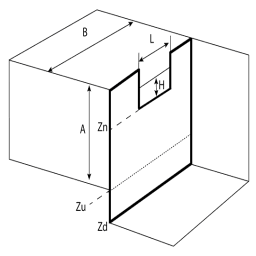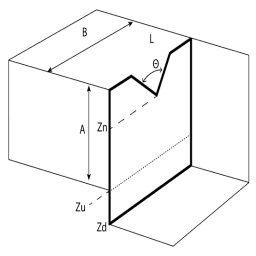Weir
Note: The Weir junction must be used with great caution. A weir inherently is for open-channel flow. However, Impulse always assumes flow is in a pipe, and that the pipe is liquid full. The loss models for the Weir junction will give a good estimate of losses associated with a weir in a system, but does not truly model open-channel flow.
The Weir junction type requires one or two connecting pipes. The Weir Properties window follows the first of the two basic Properties window formats, displaying the connecting pipes in a fixed format. A flow direction through the junction is adopted from the defined directions of the connecting pipes.
Weir Types
There are three weir configurations available. The following input data is required for each.
-
Rectangular Sharp Crested -
-
Surface Pressure
-
Notch Elevation (Zn)
-
Notch Width (L)
-
Channel Width (B)
-
Number of contractions
-
Cross-Sectional Area for Upstream and Downstream Area
-

Figure 1: Rectangular Sharp Crested Weir Model
-
V-Notch Sharp Crested -
-
Surface Pressure
-
Notch Elevation (Zn)
-
Notch Angle (theta)
-
Channel Width (B)
-
Cross-Sectional Area for Upstream and Downstream Area
-

Figure 2: V-Notch Sharp Crested Weir Model
-
Cipolletti, where the vertical angle is a 1:4 ratio -
-
Surface Pressure
-
Notch Elevation (Zn)
-
Notch Width (L)
-
Channel Width (B)
-
Cross-Sectional Area for Upstream and Downstream Area
-

Figure 3: Cipolletti (1:4 ratio) Weir Model
Notch elevation (Zn)
The absolute elevation of the bottom of the notch using the same reference frame as the pipe elevation.
Elevation of the Upstream and Downstream Areas (Zu and Zd)
The absolute elevation of the bottom of the the upstream (Zu) tank area and downstream (Zd) tank area using the same reference frame as the pipe elevation.
Number of Contractions
For a Rectangular Sharp Crested weir the notch area can be contracted from the sides of the weir. This can be from one side (1 contraction) or both (2 contractions). If the weir notch extends the full length of the channel then there are no contractions.
Upstream and Downstream Area Geometry
If the Cross-Sectional Area is specified as Constant, the weir area is assumed to be a vertical tank with constant cross-sectional area. If the cross-sectional area changes with height, this can be entered by selecting the variable option and entering the cross-sectional variation in the table.
The Tank Cross-Sectional Area is used for the purpose of determining the liquid volume. It will determine how high the liquid will rise or drop, since a given volume of liquid will flow into the weir during a time step.



